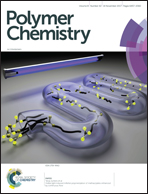Acrylamides with hydrolytically labile carbonate ester side chains as versatile building blocks for well-defined block copolymer micelles via RAFT polymerization†
Abstract
En route towards improved delivery systems for targeted chemotherapy, we propose a straightforward approach for the hydrophobic modification of the acrylamide N-(2-Hydroxyethyl)acrylamide (HEAm). An ethyl or benzyl group was introduced via a hydrolytically sensitive carbonate ester yielding HEAm-EC and HEAm-BC, respectively. Block copolymers of HEAm, respectively PEG and HEAm-EC or HEAm-BC were successfully synthesized by reversible addition–fragmentation chain transfer (RAFT) polymerization, obtaining a library of well-defined block copolymers with different degrees of polymerization (DP). To further explore the versatility of our approach in terms of polymer synthesis, self-assembly, drug solubilization and in vitro cell interaction, polyethylene glycol (PEG) and polyHEAm as hydrophilic polymer blocks were compared. The block copolymers formed micellar nanoparticles (10–100 nm) in PBS and could efficiently solubilize hydrophobic dyes and anti-cancer drugs. Benzyl carbonate ester side chains increased micellar stability and drug loading capacity. Moreover, PEG as hydrophilic block showed in comparison to HEAm more promising results concerning both colloidal stability and drug loading capacity. Confocal microscopy showed that the micelles could efficiently deliver a hydrophobic dye inside the cells. Finally, we also demonstrated efficient formulation of the anti-cancer drug paclitaxel with an in vitro cancer cell killing performance comparable or even better than the two commercial PTX nanoformulations Abraxane and Genexol-PM at equal drug dose. In conclusion, modification of HEAm through carbonate linkages offers a versatile platform for the design of degradable polymers with potential for biomedical applications.



 Please wait while we load your content...
Please wait while we load your content...